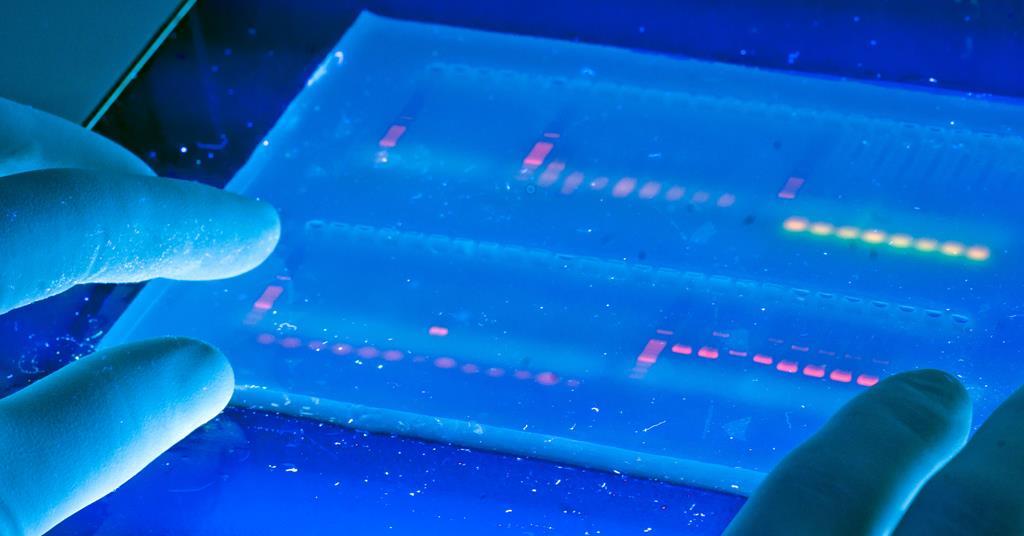Ethidium Bromide: Swap or Not

DNA Staining and Ethidium Bromide
Ethidium Bromide has been the staple DNA stain since its discovery in 1952. Originally used to treat parasites in cattle, Ethidium Bromide made its way into biology labs as a stain used for nucleic acid visualization. Ethidium Bromide wedges itself between the bases of nucleic acids in a process known as intercalation and after excitation by ultraviolet light, emits its popular orange glow.
Despite Ethidium Bromide’s use in agarose gel electrophoresis across labs throughout the world, researchers still exercise caution when working with the compound. Why? Because Ethidium Bromide can be harmful to the researcher if not handled properly or if accidents occur and it also becomes hazardous waste. Although all chemicals and equipment require some minimum level of safety, working with ethidium bromide requires heightened care and thorough treatment before disposal. In response, manufacturers have taken to creating safer and less harmful stains to minimize the use of the compound.
Issues and Trade-Offs
Alternatives to ethidium bromide were engineered to be less harmful to the researcher, however, some argue that the trade-offs aren’t worth the switch. SYBR Safe and Gel Red are just two of many alternatives when looking to replace ethidium bromide in the lab. Substitutes for ethidium bromide can be assessed in three different areas: sensitivity, absorption wavelength, and toxicity.
|
Compounds |
Sensitivity |
Absorption Wavelength |
|
Ethidium Bromide |
1 ng/band |
210 & 285 nm (Ultraviolet) |
|
SYBR Safe |
1 ng/band |
502 nm (Blue) |
|
Gel Red |
0.25 ng/band |
300 nm (Ultraviolet) |
Sensitivity
When looking at the sensitivity of the stain, meaning the smallest amount of nucleic acid that it can detect, SYBR rivals ethidium bromide with a sensitivity of a single nanogram. Gel Red blows both SYBR and ethidium bromide out of the water with its detection of just 0.25 nanograms, making it one of the more sensitive stains on the market.
Excitation
Ethidium Bromide’s orange glow comes from its excitation from wavelengths within the ultraviolet spectrum, reaching maximum absorption at 210 and 295 nm. Much like the original stain, GelRed can also be visualized using ultraviolet transilluminators without having to change the ethidium bromide filter, resulting in a similar red-orange glow. SYBR Safe differs from the other two in that it can also be excited under blue light. Exposure to UV light not only poses a threat to the user but can also compromise the integrity of the DNA for downstream applications, giving SYBR an upper hand over the others.
|
|
|
|
|
|
Toxicity
When looking into the toxicity of alternatives, our issue of finding an Ethidium Bromide substitute becomes a bit more complex. Although Ethidium Bromide is classified as a mutagen, many argue that its metabolites are mutagenic and not the compound itself. According to an Ames Test study conducted by GelRED on the mutagenic potential of Ethidium Bromide and alternatives, Salmonella TA98 and TA1537 experienced ~100x and ~15x more mutations in their colonies when metabolic enzymes were introduced. Without metabolic activation, the mutagenicity of Ethidium Bromide was similar to GelRED and the other alternatives tested. Another Ames Test study showed SYBR Safe was also found to be slightly mutagenic when metabolized by Salmonella. While the chances of the metabolization of ethidium bromide can be minimized with proper safety measures, the potential for serious danger is still there. Before its dilution, Ethidium Bromide is considered a hazardous waste under CCR Title 22, which does not take into account a compound’s mutagenicity, and requires special procedures for its disposal. Regardless of whether it's the metabolites or the compound itself, researchers should still exercise caution and proper procedures when using Ethidium Bromide.
Swap or Not
The scale at which Ethidium Bromide is hazardous to research has been a topic of heavy debate within the scientific community. When taking into account the sensitivity and visualization, alternatives like GelRed and SYBR Safe do end up showing their strengths as substitutes. Although the data does show that metabolization plays a large role in the mutagenicity of Ethidium Bromide, avoiding unnecessary exposure to the still harmful compound can minimize risk in the lab and reduce toxic waste treatment. With safer alternatives to ethidium bromide already on the market and many labs having tested them, we strongly recommend considering if these products will work for you!